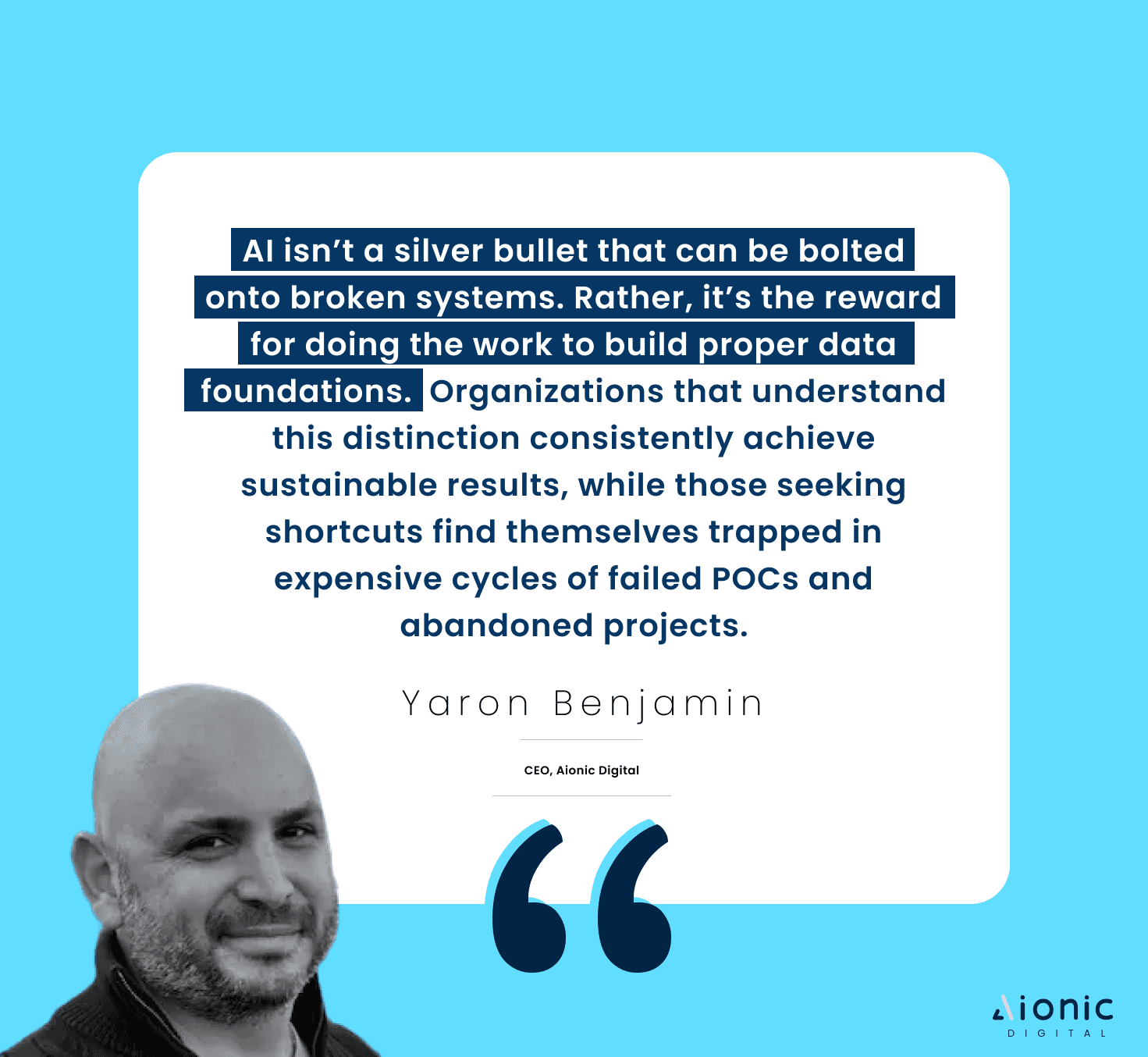
Data Maturity Model: Artificial Intelligence
Maturity Level 6. Artificial Intelligence (AI)
Picture this: Your competitor launches an AI-powered recommendation engine that boosts their conversion rates by 40%. Meanwhile, your AI pilot project is stuck producing recommendations for products that don’t exist, predicting demand for discounted items, and generating customer insights based on duplicative records.
What’s the difference? The preferred solution, in this scenario, was built on a foundation of mature data practices, while the sub-optimal solution tried to take a shortcut to the finish line.
For months, we’ve traced the evolution of data maturity, from chaotic source systems to sophisticared business intelligence. Each maturity level outlined, be it data engineering, storage, analytics, and business intelligence have brought us closer to operational clarity. But clarity isn’t the endgame – Intelligence is!
And while Business Intelligence answers the historian’s question, “What happened?” Artificial Intelligence answers the Strategist’s questions, “What will happen next? And what should we do about it?” This isn’t just an upgrade. Rather, it’s a fundamental shift from reactive to proactive. From descriptive to prescriptive. From hindsight to foresight.
Decoding the AI Ecosystem: Your Strategic Options
The AI landscape can feel overwhelming, but understanding three core approaches will clarify your options.
Machine Learning: The Pattern Detective 🕵🏻♂️
At its core, Machine Learning transforms historical data into predictive power. It’s the technology behind demand forecasting that prevents stockouts, fraud detection that saves millions, and recommendation engines that drive personalization at scale. Machine Learning can be thought of as your data’s memory becoming your business’s crystal ball.
Generative AI: The Creative Catalyst 🧞♂️
GenAI doesn’t just analyze, it creates. That is, natural language queries turn your dashboards conversational. Content generation scales your marketing and makes hyper-personalization possible. Code generation accelerates your development cycles. Collectively, it’s like having additional staff who never sleep and who learn from every interaction.
Traditional AI: The Optimization Engine 🚂
Before the current AI boom, intelligent systems were already being used to optimize things like delivery routes, workforce schedules, and compliance workflows. These rule-based systems remain powerful, especially when combined with modern Machine Learning and Generative AI capabilities.
The Foundation Fallacy: Why you can't skip steps!
The uncomfortable truth is that AI, without mature data foundations, doesn’t create intelligence. It actually amplifies chaos. Every previous maturity level serves as a critical enabler to an AI solution.
Sources Systems provide the complete, reliable foundation that AI demands. Engineering and Sanitization ensures that your models learn from clean, standardized data – not inconsistencies and errors that create biased and/or inaccurate predictions. Storage Architecture makes data accessible, at the scale that AI requires. Vector databases extend traditional warehouses, enabling the semantic search that powers modern GenAI applications. Analytics serves as the bridge to AI, with statistical models often evolving into more sophisticated Machine Learning algorithms. Business Intelligence becomes AI-enhanced, transforming static dashboards into conversational interfaces that deliver proactive insights.
Skip any of these steps, and your AI initiative risks becoming expensive experiments in amplifying existing data problems. While we all wish we could skip to the finish line, it’s imperative that we understand the discrete steps that must be taken in order to operationalize a meaningful AI solution that can change your business.
The Prize
Enough about the importance of addressing each maturity level – what can businesses truly gain from an AI solution that is built on the correct data foundation? While benefits are plentiful, organizations that reach AI maturity unlock value across three key dimensions: Efficiency Gains, Optimization, and Innovation.
Efficiency Gainsare one of the most sought-after benefits of AI solutions. It’s an appealing benefit for brands of all shapes and sizes. It allows small organizations to do more with a small team. It allows large organizations to free-up staff to focus on innovation. And yes, it’s the basis for “will AI replace us?” concerns. Using AI, automation handles repetitive tasks, accelerates workflows, and frees human talents for more strategic work. Customer service chatbots, automated reporting, and intelligent document processing exemplify this category.
The second critical benefit of AI solutions is the identification of optimization opportunities. Who doesn’t want to improve business operations, sales, or marketing with minimal effort? AI fine-tunes complex decisions across your entire operation. Supply chain optimization, dynamic pricing, predictive maintenance, and targeted marketing campaigns all fall in this high-impact category.
Lastly, AI is a force when it comes to unlocking innovation potential. Perhaps the most transformative impact comes from the creation of entirely new products, services, and customer experiences. AI-powered features, new revenue streams, and competitive differentiation opportunities emerge at this level.
A Final Note
In short, the most successful AI implementations share a common characteristic: they’re built by organizations that treated AI as the culmination of a data maturity journey, not as a magical solution to bypass fundamental data challenges. AI isn’t a silver bullet that can be bolted onto broken systems. Rather, it’s the reward for doing the work to build proper data foundations. Organizations that understand this distinction consistently achieve sustainable results, while those seeking shortcuts find themselves trapped in expensive cycles of failed POCs and abandoned projects.
We hope this guide has been helpful for you and your organization. The future belongs to organizations that can transform data into intelligence, insights into actions, and patterns into predictions. And it’s not about just about having better data - it's about building intelligence that transforms how you compete, operate, and innovate.
It is our hope that this Data Maturity Readiness model helps you identify your current state and begin charting a path towards your end-goal.
Jumpstart your AI journey!
Ready to accelerate your path to AI – all while avoiding the pitfalls that doom AI initiatives from the start? For guidance on assessing your organization's readiness for AI implementation, or to explore how proper data foundations can accelerate your AI initiatives, contact our team at Aionic!